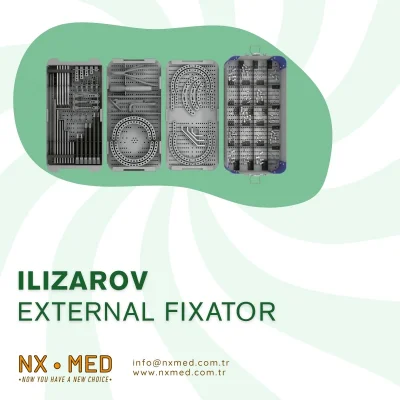EXTERNAL FIXATOR SYSTEM TYPES AND INDICATIONS
- Home Page
- EXTERNAL FIXATOR SYSTEM TYPES AND INDICATIONS
EXTERNAL FIXATORS | |
 | External fixation is the method of controlling and fixing the fragments by connecting them with external metal devices with the help of pins, screws or wires applied externally to the bone from the proximal and distal parts of the fracture, and external fixation. Fixators are systems obtained by attaching wires or pins passed through the bone to a rigid support outside the broken bone of extremity. |
FIXATOR TYPES:The system created with clamps fixed on a unilateral body or rail is called Monolateral Fixator. The modular system established with clamps placed on round rods is called Tubular Fixator. Tubular Fixators are defined as multi-axis fixation system as they allow pins to be sent to each other at different angles on the round rod. The Circular Fixator or Ilizarov System are systems in which the broken bone is fixed from the outside with wires and pins. Hybrid Fixator systems, on the other hand, are mixed systems in which the circular system and tubular or monolateral system are used together. There are systems in which Hybrid Fixator rings are also modified and used. |  |
EX-FIX ADVANTAGES:Circular systems are heavy and bulky, but tubular or monolateral systems are light and modular. Hybrid external fixator systems aim to combine the advantages of both types and reduce their disadvantages. The implants used must be biocompatible and have sufficient durability. | |
 | There are span and non-span fixation options for wrist and ankle fractures. In the Spannig fixation model, the distal radius fragments are minimally fixed with wires. Then the joint is distracted by placing a fixator between the second metacarpal and the radius shaft. In the non-spanning technique, the distal radius fragments and radius shaft are fixed with a fixator. Reduction is provided. The wrist joint is released. |
EXTERNAL FIXATOR INDICATIONS: | |
| |
EXTERNAL FIXATORS

Ilizarov External Fixator System
Ilizarov External Fixator System The Ilizarov external fixator system is a revolutionary orthopedic device used primarily for the treatment of complex fractures, limb lengthening, and deformity correction.
More
TUBULAR EXTERNAL FIXATORS
Tubular External Fixator: Components and Clinical Applications Introduction The tubular external fixator represents a versatile and modular system for fracture stabilization and deformity correction in
More
TUBULAR EXTERNAL FIXATOR PARTS
Composed of several parts, the tubular external fixator delivers a highly adjustable and systematic solution for supporting complex fracture treatments. This system of tubular fixators consists of multiple
More
Metafix - Clinical Informations
METAFIX FOOT DEFORMITY CORRECTION SYSTEM Metatarsal lengthening fixators are mini external fixation systems applied to increase bone length on the toes (especially the 4th metatarsals). These systems are
More